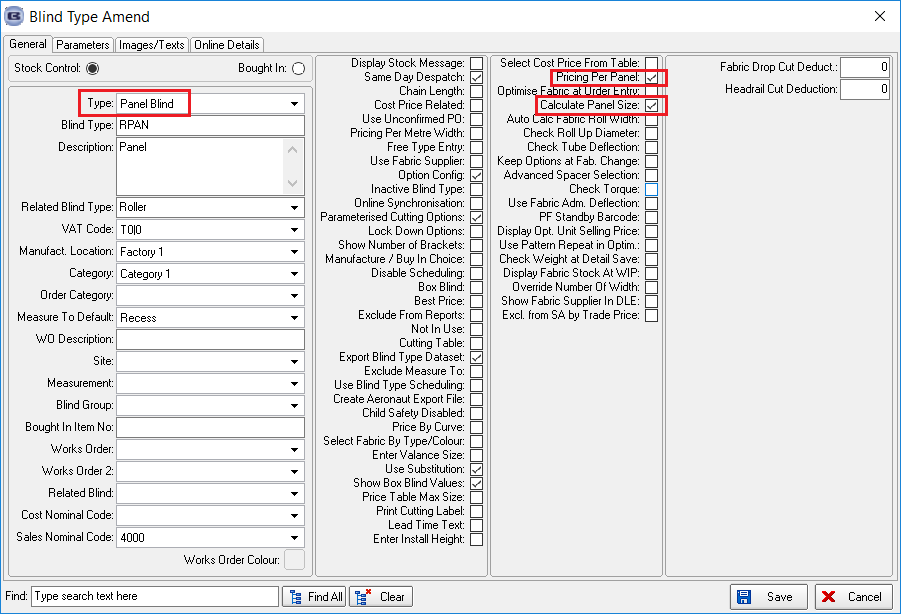How To Setup Panel Blind Type¶
There is a blind identifier called ‘Panel Blind’.

Recently we created a new blind identifier, Panel Blind (J). We have now created some extra features for this.
1. There are two new forms in Administration > System Tables called Single Bunch Panel Blinds and Split Bunch Panel Blinds. The underlying table holds number of panels, number of channels, single/split (true/false), blind width, panel size.
2. When a detail line is entered for a panel blind, we need to know the number of panels. There is a field to enter this (similar to the way the number of vanes is entered for a vanes only blind).
3. One of the options set up will be single/split bunch, because we need to know if all the panels will go to one side or be split (just like a vertical blind).
4. On the works order, we now display the number of panels, the number of channels and the width of the panels.
If blind identifier = ‘Panel Blind’, there is a flag called ‘Calculate Panel Size’. If this is true, the panel width size is calculated by a formula instead of looking up a table.
If ‘Calculate Panel Size’ = true, another field is displayed called ‘Overlap Size’. This is also required to calculate the panel size.
The formula is:
Panel width = (Width (Blind Size) – Headrail Cut Deduction + (Overlap Size * (number of panels – 1))) / number of panels.
If ‘Calculate Panel Size’ = true, then the panel size prints on ‘Works Order Label Blind Size’.
Panel Blind Pricing
If the blind identifier = Panel, there is now an additional method of pricing. The panel blinds can be priced per panel (in the same way as vanes only is priced per vane and the prices are held in Pricing > Vanes Price Table).
The Pricing > Vanes Price Table form has been changed so that the user can select a blind type that is either blind identifier = Vanes Only or Panel Blind.
There is a flag in the blind type form called ‘Pricing Per Panel’.
If this is set to true, then in order detail entry, when a panel blind is entered, the price is found by looking at the number of panels, drop, price code and fabric group and selecting it from the relevant record in ‘Vanes Price Table’.
Panel Blind Calculator
A new calculation is required for fabric when used in a panel blind. Panel blinds are usually made with roller fabrics.
We would normally set up a blind type for a panel blind with ‘Related Blind Type’ = Roller, because they share the same fabrics.
However, this causes a problem when the stock calculation is done for panel blinds, as we are not using the same amount of fabric as a roller blind.
Therefore we have made adjustments to calculators ‘Drop’, ‘Width’ and ‘Width or Drop’ to allow for the blind identifier.
If the blind identifier = Roller, then these calculators remain the same. If the blind identifier = Panel Blind, then the fabric is calculated as follows:
There are 3 things needed to work out how much fabric to use for a panel blind.
1. Panel width – the panel width is worked out either from the panel size in ‘Single Bunch Panel Blinds’ or ‘Split Bunch Panel Blinds’, or if ‘Calculate Panel Size’ = true in the blind type record, then it is calculated.
2. Panel drop – this is the ‘Man Drop’ – ‘Fabric Drop Ded. Calc’ in the blind type record.
3. Number of panels – this is the number of panels in the order detail line.
Therefore can calculate how much fabric we need ie the total of all the panel pieces.
This logic is similar to a roller blind that has a join ie more than one piece of fabric is required.
It is then possible to optimise the fabric in the usual way.
We have made an alteration to the way the amount of fabric is calculated if a panel blind is made using roller fabric.
We introduced code a while ago to do the calculation for panels ie if calculator = ‘Width or Drop’ and blind identifier = Panel, then calculate the amount of fabric according to the number of panels.
A problem has arisen where the panel blinds do not look good if width is used.
We therefore now calculate the amount of panel blind fabric based only on drop ie the fabric will always be calculated using ‘Drop’ calculator.
Therefore if blind identifier = Panel and calculator = ‘Width or Drop’, calculator ‘Drop’ is used instead.
Also, if the total of the panel widths > roll width, then the BOM quantity previously did not get calculated properly.
It now doubles the quantity of fabric required, or possibly triples it.
For example, if 3 panels are required that are 900mm wide and the drop is 2200mm, and the roll width is 1900mm, then 4400mm of fabric would be required. If 5 panels of this size were required, then 6600mm would be required.
Panel Blinds Calculator
There is a calculator called ‘Panel Multiple’. This multiplies the quantity field in the relevant record in the ‘Dimension Calculation’ table by the number of panels required for the blind.
There is a check to see if the number of panels entered in an order detail line is > the minimum number of panels.
This involves checking the ‘Single Bunch Panel Blinds’ or ‘Split Bunch Panel Blinds’ tables to see if the number of panels entered is >= the lowest number of panels in these tables (depending on bunch selected).
If not, a message appears saying ‘The minimum number of panels is n’, where n is the lowest number of panels.